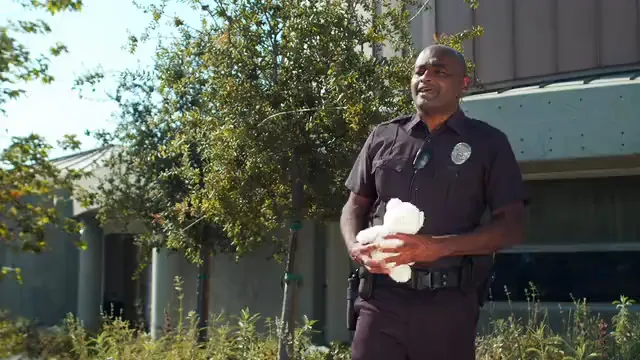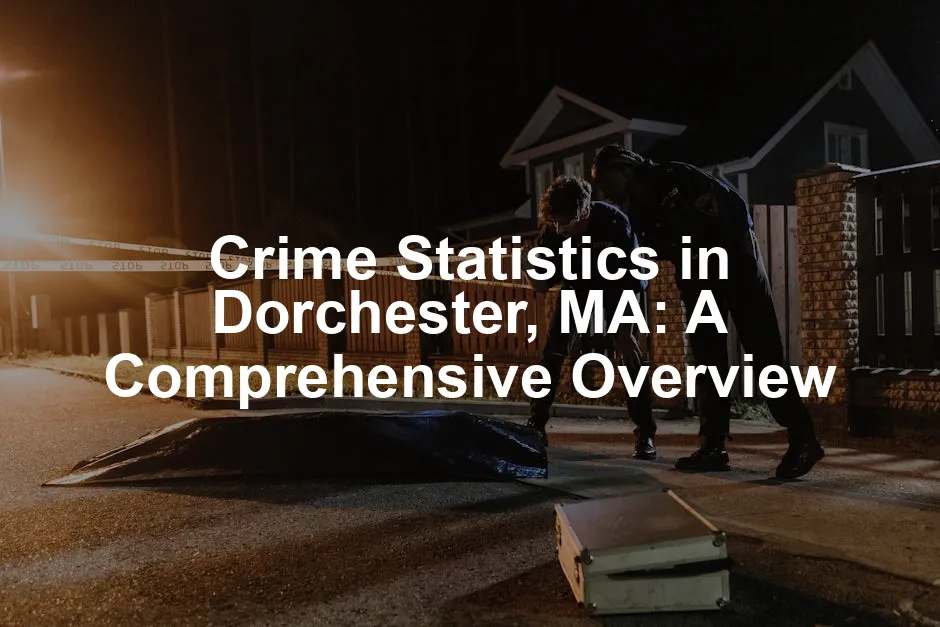Introduction
Crime statistics tell a story. They reflect the safety and security of our communities. For residents of Dorchester, MA, these numbers are more than just figures; they are indicators of how safe – or unsafe – their neighborhood can feel. Understanding crime statistics is crucial for everyone, from longtime residents to potential homebuyers and policymakers.
Why does this matter? For residents, knowledge of crime data can influence daily decisions, such as when to walk home at night or whether to engage in community activities. Prospective homebuyers often look at crime rates to gauge the safety of an area, ultimately affecting their investment decisions. Policymakers rely on these statistics to allocate resources and implement programs aimed at reducing crime and enhancing community safety.
This article aims to provide a thorough examination of crime trends, statistics, and safety perceptions in Dorchester. We will break down various crime categories, highlight recent trends, and explore how Dorchester compares to other neighborhoods in Boston. Buckle up, because we’re about to take a ride through the numbers!

Understanding Crime Statistics
What Are Crime Statistics?
Crime statistics are data collected to quantify crime in specific areas. These numbers help us understand the prevalence and nature of crime, enabling communities to develop strategies for prevention and response. Most crime statistics fall into two categories: violent crimes and property crimes.
Violent crimes involve force or threat of force and include offenses like murder, assault, and robbery. These incidents can leave lasting impacts on victims and communities alike. Property crimes, on the other hand, involve the theft or destruction of someone else’s property. Examples include burglary, theft, and vandalism. Understanding the difference between these two types is key for grasping the full picture of community safety.

Sources of Crime Data
Where do these crime statistics come from? Several sources contribute to our understanding of crime in Dorchester. One of the most significant is the FBI’s Uniform Crime Reporting (UCR) program. This program collects data from law enforcement agencies nationwide, offering a broad view of crime trends across the country.
Local law enforcement agencies also play a vital role in reporting crime data. For instance, the Boston Police Department regularly releases crime statistics, which provide insights into the specific challenges and trends facing Dorchester. However, accuracy is paramount. Discrepancies can arise due to underreporting or differences in how crimes are classified. Therefore, it’s essential to consider various data sources to form a comprehensive view of crime in Dorchester.
Armed with this understanding, let’s move forward and explore the crime landscape in Dorchester, examining the trends that shape the community’s safety perception. And speaking of safety, consider investing in a Neighborhood Watch Sign. It’s a simple yet effective way to alert potential troublemakers that your community is vigilant!

Crime Overview in Dorchester, MA
General Crime Trends
Dorchester has become a focal point in understanding crime trends in Boston. Over the past few years, crime rates in Dorchester have displayed a mixed bag of results. In 2017, Dorchester saw a notable 10% drop in crime, with almost 200 fewer reported incidents compared to 2016. This decline, however, isn’t the full story.
While property crimes such as burglary and robbery decreased, violent crimes, particularly homicides, have raised eyebrows. The neighborhood reported 16 homicides in 2017, a significant jump from the previous year. The overall crime rate remains a crucial topic of discussion for residents, prospective homebuyers, and city officials.
When compared to other neighborhoods in Boston, Dorchester holds its ground. For instance, South End and Roxbury reported significantly higher crime totals. In 2022, Dorchester recorded around 2,034 crimes, significantly fewer than Roxbury’s 2,710 and South End’s 3,627. However, it’s essential to consider Dorchester’s larger population of approximately 124,000 people. Adjusting for population, the crime rate per 1,000 residents in Dorchester stands at about 16.34, making it one of the safer neighborhoods in the city.

Recent Crime Rate Changes
Recent reports indicate fluctuations in specific crime categories. For example, while property crimes generally saw declines, violent crimes displayed a worrying trend. According to Boston Police data, there was a 1% decrease in overall crime citywide, but Dorchester’s homicide count rose from 10 to 16 in one year. This statistic highlights the importance of continuous monitoring and community engagement.
Local law enforcement’s reports show that while burglaries and assaults have seen a reduction, the increase in homicides has created a sense of urgency. The community is encouraged to remain vigilant and proactive in crime prevention efforts. With a focus on collaboration between residents and law enforcement, the goal is to sustain the positive trends while addressing the spikes in violent crime.
Speaking of vigilance, consider arming yourself with a Personal Safety Alarm. It’s a small device that can make a big difference in keeping you safe!

Comparison with Boston and National Averages
Now, let’s put Dorchester’s crime statistics under the microscope and compare them with Boston and national averages. The following table summarizes the crime rates for Dorchester, Boston, and the national averages.
| Crime Type | Dorchester (Rate per 100k) | Boston (Rate per 100k) | National Average (Rate per 100k) |
|---|---|---|---|
| Violent Crime | 3,955 | 678 | 322 |
| Property Crime | 11,514 | 2,427 | 1,070 |
| Murder | 44 | 46 | 2.1 |
| Assault | 2,965 | 3,206 | 253.1 |
| Burglary | 1,213 | 1,271 | 142.8 |
Analyzing this data reveals that Dorchester’s violent crime rate is alarmingly higher than both the Boston average and the national average. Property crime, while also higher, reflects a similar trend. For instance, the overall violent crime rate in Dorchester is nearly six times higher than the national average, posing a challenge for community safety.

In summary, while Dorchester has made strides to reduce certain crime rates, comparisons with Boston and national averages emphasize ongoing challenges. The community must engage in proactive discussions, build partnerships, and explore innovative strategies to enhance safety. Understanding these statistics is vital for all stakeholders involved, from residents to city planners. As we proceed to detailed crime statistics, let’s keep the focus on collaboration and community resilience.
Recent Trends in Violent Crime
Violent crime in Dorchester has been a hot topic lately. The latest reports show a concerning trend. In 2022, Dorchester recorded 16 homicides, a significant increase from 10 the previous year. This spike drew attention from residents and local authorities alike. Fortunately, other violent crimes, such as assaults, have seen a slight decline. Overall, while some categories improve, the rise in homicides has raised eyebrows.
Local law enforcement emphasizes the importance of community vigilance. They encourage residents to stay engaged in safety initiatives. After all, a well-informed community can make a difference in crime prevention. And let’s not forget the importance of self-defense! A Self-Defense Keychain can be a stylish yet practical tool to carry with you!

Property Crime Statistics
When we shift gears to property crimes, the numbers tell a different story. Dorchester’s property crime rates include burglaries, thefts, and vehicle thefts. In 2022, the area reported an alarming total of 11,514 property crimes. To put this in perspective, that’s significantly higher than both Boston’s average of 2,427 and the national average of 1,070.
Breaking it down further, burglaries accounted for 1,213 incidents, while thefts were responsible for a staggering 9,116 cases. Vehicle theft also posed a challenge, with 1,185 reported incidents. As you can see, Dorchester faces substantial property crime issues, highlighting the need for ongoing community efforts to enhance safety.

Trends in Property Crime
Over the years, property crime statistics in Dorchester have shown some fluctuations. While the overall trend has leaned toward a gradual increase, specific years have displayed reductions. For instance, in 2017, the neighborhood noted a 10% drop in crime, largely due to effective law enforcement strategies. However, the property crime rate surged again in subsequent years, raising alarms among community members.
In a broader context, Dorchester’s property crime rates remain higher than those of surrounding areas. As neighborhoods evolve, residents must remain proactive. Engaging with local law enforcement and participating in community programs can help mitigate these issues. And don’t forget, having a First Aid Kit handy is a must for any household!

Neighborhood-Specific Crime Data
Crime rates can vary significantly across different neighborhoods in Dorchester. For instance, North Dorchester has reported crime rates considerably higher than South Dorchester. A closer look reveals the following data for 100,000 residents:
| Neighborhood | Violent Crime Rate | Property Crime Rate |
|---|---|---|
| North Dorchester | 3,955 | 15,469 |
| South Dorchester | 3,200 | 11,514 |
The tables illustrate the stark differences in crime rates. North Dorchester is particularly concerning, with violent crime rates soaring above national averages. Conversely, South Dorchester, while still facing challenges, has a relatively lower crime rate. This data underscores the importance of neighborhood-specific strategies to improve safety within Dorchester.
By understanding these trends and statistics, residents can take informed actions to bolster their community’s safety. And remember, a good Crime Prevention Book can provide practical tips and strategies to keep your family safe.

Community Safety Perception
Resident Surveys and Feelings of Safety
How safe do residents feel in Dorchester? A recent survey sheds light on this topic. Out of 52 respondents, 50% reported feeling “pretty safe,” which means they recognize some safety concerns but generally feel secure. However, 33% said they felt “somewhat safe,” indicating noticeable safety concerns that sometimes leave them uneasy. Alarmingly, 8% admitted they don’t feel safe at all.
Such numbers highlight the mixed feelings within the community. Residents often ponder: Does the police presence make a difference? According to another survey of 51 participants, 43% believe police are highly visible and responsive. However, 25% feel police are present but slow to respond when needed. A mere 6% feel that law enforcement is unreliable. Clearly, there’s room for improvement in community-police relations.

Feedback indicates that while many appreciate police visibility, they crave quicker response times and more proactive engagement. How can this be achieved? Regular community meetings might be a good start. By fostering open dialogue, residents can express concerns and suggest improvements. And if you’re concerned about personal safety during these meetings, consider bringing along a Pepper Spray for added peace of mind.
Law Enforcement and Community Relations
Local law enforcement plays a pivotal role in addressing crime. The Boston Police Department actively engages with the Dorchester community through various programs. These initiatives aim to build trust and improve safety. For instance, neighborhood watch programs empower residents. They encourage locals to look out for one another and report suspicious activities.
Additionally, the police have implemented community policing strategies. Officers work closely with residents, attending neighborhood events and hosting safety workshops. These efforts help to strengthen the bond between law enforcement and the community.

Recent statistics show a decline in certain crime categories, indicating that these strategies might be working. However, the rise in violent crimes, particularly homicides, calls for ongoing vigilance. Residents and police alike must remain proactive to ensure a safer Dorchester. And while you’re at it, consider having a Fire Extinguisher at home for an extra layer of safety!

Resources and Tools for Residents
Crime Maps and Reporting Tools
Residents of Dorchester have access to various resources designed to keep them informed about local crime. Crime maps offer a visual representation of reported incidents, color-coded to indicate areas of higher or lower crime. This tool helps residents make informed decisions about their safety.
For example, the North Dorchester crime map illustrates that this area has crime rates 34% higher than the national average. The violent crime rate here is particularly concerning, sitting at 83% higher than the national average. Such statistics encourage residents to stay vigilant.
Moreover, local law enforcement agencies provide online reporting tools. These allow residents to report crimes or suspicious activities quickly and easily. Engaging with these tools fosters community involvement in crime prevention. And don’t forget, having a Emergency Whistle can be a lifesaver in a pinch!

Staying Informed and Engaged
To enhance personal safety, residents should utilize available resources. Subscribing to neighborhood newsletters or local police alerts can keep them updated on crime trends. Participating in community forums offers additional insights, allowing residents to share experiences and strategies for improving safety.
Finally, getting involved in local organizations can pave the way for stronger community ties. Programs that focus on safety and crime reduction can unite residents toward a common goal—creating a safer Dorchester for everyone. By staying informed and engaged, residents can play a vital role in ensuring their community remains safe and welcoming. And if you’re an outdoor enthusiast, consider having a Camping Survival Gear handy for your next adventure!

Safety Tips for Residents
Staying safe in Dorchester doesn’t have to feel like a full-time job. A few practical tips can go a long way. First, always be aware of your surroundings. This means putting your phone down and keeping your eyes peeled. If something feels off, trust your instincts!
Consider joining or forming a neighborhood watch program. These groups foster community spirit and collective vigilance. When residents look out for each other, it creates a safer environment. Plus, it’s a great way to meet your neighbors—who knows, you might find a new best friend!
Engaging with local law enforcement can also enhance safety. Attend community meetings to voice concerns and learn about new initiatives. Building a solid relationship with police helps everyone stay informed. And don’t forget to keep a Portable Phone Charger with you—because nothing says “I’m safe” like a fully charged phone!
FAQs
What is the overall crime rate in Dorchester compared to Boston?
Dorchester has a lower crime rate than Boston overall. With approximately 16.34 crimes per 1,000 residents, it ranks as one of the safer neighborhoods in the city. Boston’s general crime rate sits at around 26 crimes per 1,000 residents, indicating Dorchester’s relative safety.
How can residents report crime in Dorchester?
Residents can report crime in Dorchester by contacting the Boston Police Department directly. They can call 911 for emergencies or use the non-emergency number for less urgent matters. Additionally, online reporting tools are available for certain incidents, making it easier for residents to stay involved.
Are there specific areas in Dorchester that are safer than others?
Yes, some areas in Dorchester exhibit lower crime rates than others. South Dorchester tends to be safer than North Dorchester. Engaging in neighborhood watch programs and fostering community connections can enhance safety further.
How does Dorchester’s crime rate compare to the national average?
Dorchester’s crime rate is higher than the national average. While national averages show around 1,392 total crimes per 100,000 residents, Dorchester’s figures are significantly elevated, particularly in violent crime categories. Acknowledging this helps residents remain vigilant and proactive in their safety efforts.
For a detailed look at crime statistics in the area, you can check out the dorchester crime statistics.
Please let us know what you think about our content by leaving a comment down below!
Thank you for reading till here 🙂
All images from Pexels




